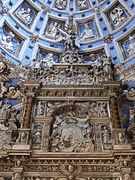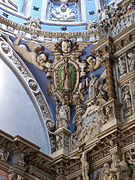Boim Chapel
The Boim Chapel ( Ukrainian Каплиця Боїмів Kaplyzja Bojimiw , Polish Kaplica Boimów ), also Gethsemane Chapel called, is a Renaissance Chapel in Lviv , near the Roman Catholic Cathedral .
history
It was donated by Georg (György) Boim from Hungary , a merchant and city councilor of Lemberg, the secretary of the Polish king Stephan Báthory , as a burial chapel for his family.
The chapel was built at the beginning of the 17th century next to the Roman Catholic cathedral on the cemetery grounds. The cemetery was closed in the 18th century.
The chapel was built by Andreas Bemer. The sculptural jewelry is the work of two Wroclaw sculptors: Johann Scholz (* 1573 in Wroclaw , † before 1642 in Brzeżany ) and Johann (Hans) Pfister (* August 5, 1573 in Wroclaw, † 1642 in Lemberg ).
The chapel was built on a square plan. It is crowned by a cassette dome on a drum with pendentives . On the dome is a lantern with a figure of Christ as a man of sorrows . The arrangement is similar to that of the Sigismund Chapel in Kraków's Wawel Cathedral . The chapel was built free-standing, and a tenement house was added from the southern side in the 19th century.
The chapel is assigned to the art of the late Renaissance with Dutch influences. With its excessive decoration, it is inferior to the Krakow Renaissance buildings, but it is an example of bourgeois architecture.
On the east facade, divided by five pilasters, there are portraits of Georg Boim and his wife Jadwiga (Hedwig), painted in 1617 by Giovanni Gianni.
On the north facade there are frescoes depicting Christ and the Mother of God Mary. On the side wall of the octagonal drum there is a bas-relief with St. George fighting the dragon. This facade is attributed to Andreas Bemer.
The richly decorated west facade is the work of Johann Scholz. It is divided over three floors with six columns and two cornices.
The highest floor shows the scenes from the passion story: the flagellation of Jesus , the way of the cross , the crucifixion and the descent from the cross .
The interior decoration is mainly the work of Hans Pfister. The dome's cassettes are filled with sculptures. The altar wall is divided into three horizontal rows and extends to the dome. The sculptures were mostly carved in the local limestone, higher stucco was used. There are also fragments in black marble and white alabaster . The lower cornice is supported by figures of the four prophets. The door leaves are decorated with inlays and decorative fittings.
On the south wall are the epitaphs, created by Hans Pfister in marble and alabaster.
The portraits of Georg Boim and his son Paul were hung over the entrance door.
The chapel was administered by the Boim family until the 18th century, when it came under the administration of the Roman Catholic cathedral. In 1945 it was closed by the Soviet authorities and fell into disrepair due to insufficient maintenance. Since 1969 it has been part of the Lviv Picture Gallery.
photos
literature
- Hermann Simon, Irene Stratenwerth, Ronald Hinrichs: Lemberg. A trip to Europe. Ch. Links Verlag, Berlin 2007, ISBN 978-3-86153-459-4 , pp. 161-164.
Web links
Coordinates: 49 ° 50 ′ 27 ″ N , 24 ° 1 ′ 53 ″ E








